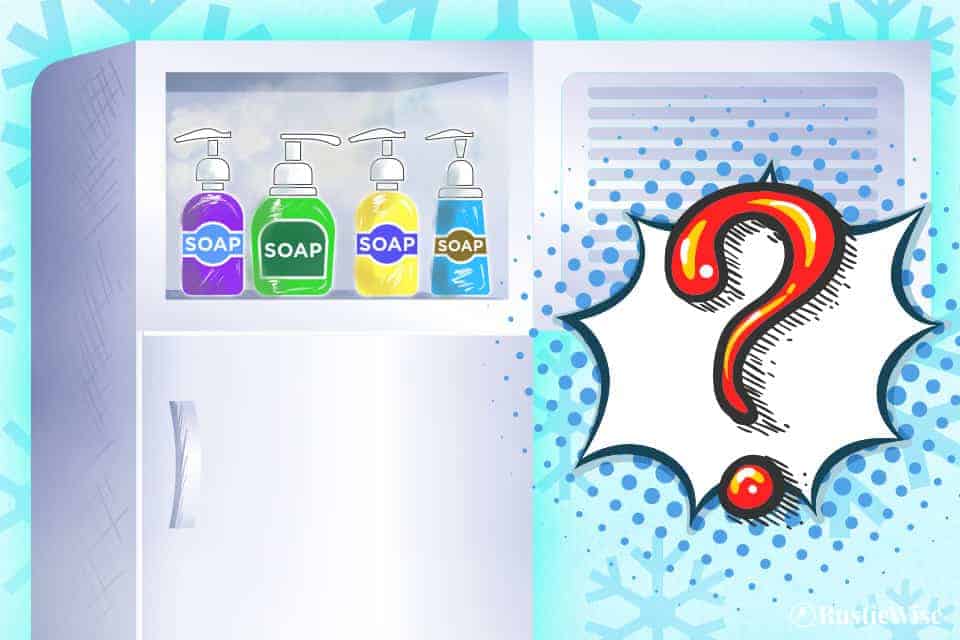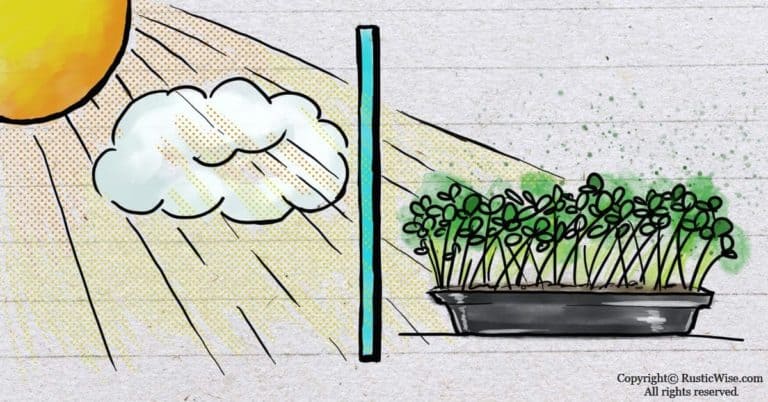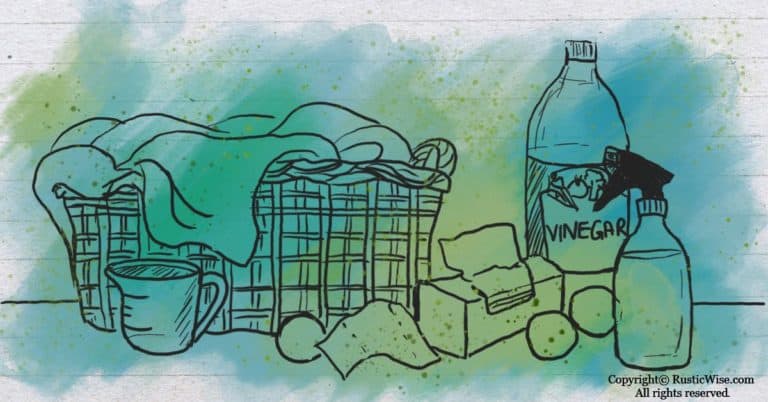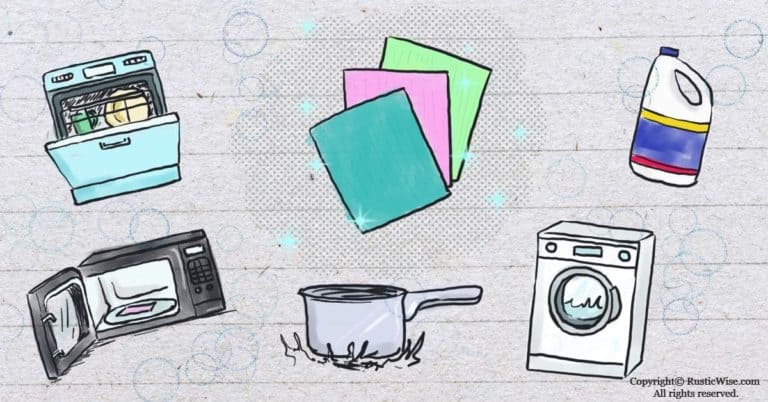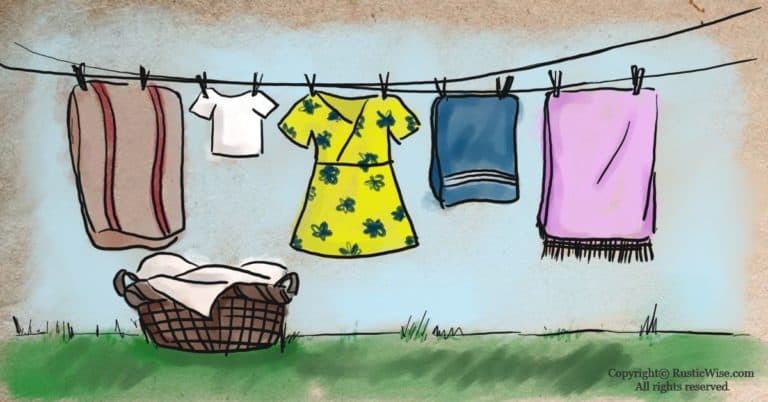Does Soap Freeze? An Experiment with Liquid Dish Soap vs. Castile Soap
RusticWise is supported by its readers. When you purchase through links on our site, we may earn an affiliate commission. As an Amazon Associate, we earn from qualifying purchases. Thank You!
We know that the freezing point of water is 32 degrees Fahrenheit (0 degrees Celsius), but what about other common household items like dish soap, or Castile soap? After reading a variety of responses online (some say dish soap only turns slushy, it doesn’t really freeze) I decided to do my own little experiment.
Does soap freeze? The simple answer is yes, any form of liquid soap will eventually freeze as one of the key components is water. Other ingredients added to commercial soap may lower the freezing point, making it less prone to solidifying. Most dish soaps contain ethanol (ethyl alcohol) which controls viscosity and acts as a stabilizer, making it less prone to freezing. Most soaps freeze between 12 to 14 degrees Fahrenheit (-10 to -11 degrees Celsius).
The good news is that if you accidentally left a bottle of dishwashing soap or Castile soap in subzero temperatures, it may not freeze as easily as you think. Let’s take a closer look at some soapy science and how to properly store your suds.
What are the ingredients in dish soap?
While water makes up the bulk of the ingredients in commercial dish soap, there are many other ingredients which affect the freezing point of soap.
Whether you use Dawn dish soap, Palmolive, or some other brand, most detergents contain similar ingredients. Here’s a quick look at what the average bottle of liquid dishwashing soap contains:
- Water
- Surfactants: This class of ingredient produces plenty of suds and helps decrease surface tension of water. This allows food particles, oil, and grease to more easily wash clean.
- Suds boosters and stabilizers: This includes substances such as acyl or fatty acid ethanolamides which help create longer lasting bubbles.¹
- Lye: Lye, whether potassium hydroxide or sodium hydroxide, is used as a buffering agent to adjust the pH level in liquid soaps.
- Opacifying and/or colorants: These are synthetic coloring agents which can also affect the opacity of the finished product.
- Fragrance: Each individual fragrance may comprise dozens of unlisted chemicals.
- Ethyl alcohol (ethanol): This alcohol is used in small amounts to stabilize viscosity and provide resistance to temperature fluctuations.
This ingredient makes dish soap resistant to cold temperatures
While pure water freezes at 32 degrees Fahrenheit (0 degrees Celsius), adding other ingredients to a solution can affect the overall temperature at which it freezes.
One such ingredient in dish soap is ethyl alcohol, aka ethanol. The freezing point of ethanol (C₂H₆O), is around −173 degrees Fahrenheit (−114 degrees Celsius).²
According to the American Cleaning Institute (ACI), “The alcohols used in light duty and liquid laundry detergents are isopropanol or ethanol (ethyl alcohol). These alcohols are used at low levels in liquid detergent formulations to control viscosity, to act as a solvent for other ingredients, and to provide resistance to low and freezing temperatures encountered in shipping, warehousing, and use.”¹
The takeaway: The formulation of dish soaps is designed to withstand cold temperatures during shipping and handling. The individual ingredients added to a water solution such as soap will affect the temperature at which it freezes.
What are the ingredients in Castile soap?
Castile soap is a vegetable oil based soap that typically contains fewer chemicals than traditional hand dishwashing soaps.
You’ll typically find the following ingredients in liquid Castile suds, such as Dr. Bronner’s:
- Water
- Vegetable oils: Castile comprises a blend of plant-based oils selected for their moisturizing or cleansing properties, including coconut oil, palm oil, olive oil, hemp oil, and jojoba oil.
- Citric acid: Used to adjust the pH level.
- Lye: Sodium hydroxide is used as a pH adjuster and buffering agent.
- Tocopherol: Also known as vitamin E, this antioxidant is good for skin and prevents oils from oxidizing.
What is the freezing point of soap?
The freezing point for soap depends on its ingredients. Typically, the freezing point for dish soap is somewhere between 12 to 14 degrees Fahrenheit (-10 to -11 degrees Celsius). Some soaps freeze at a lower temperature than others.
Under normal storage conditions, it’s unlikely that dish soap will freeze. Even if you have a chilly basement, your bottle of suds should be safe from freezing.
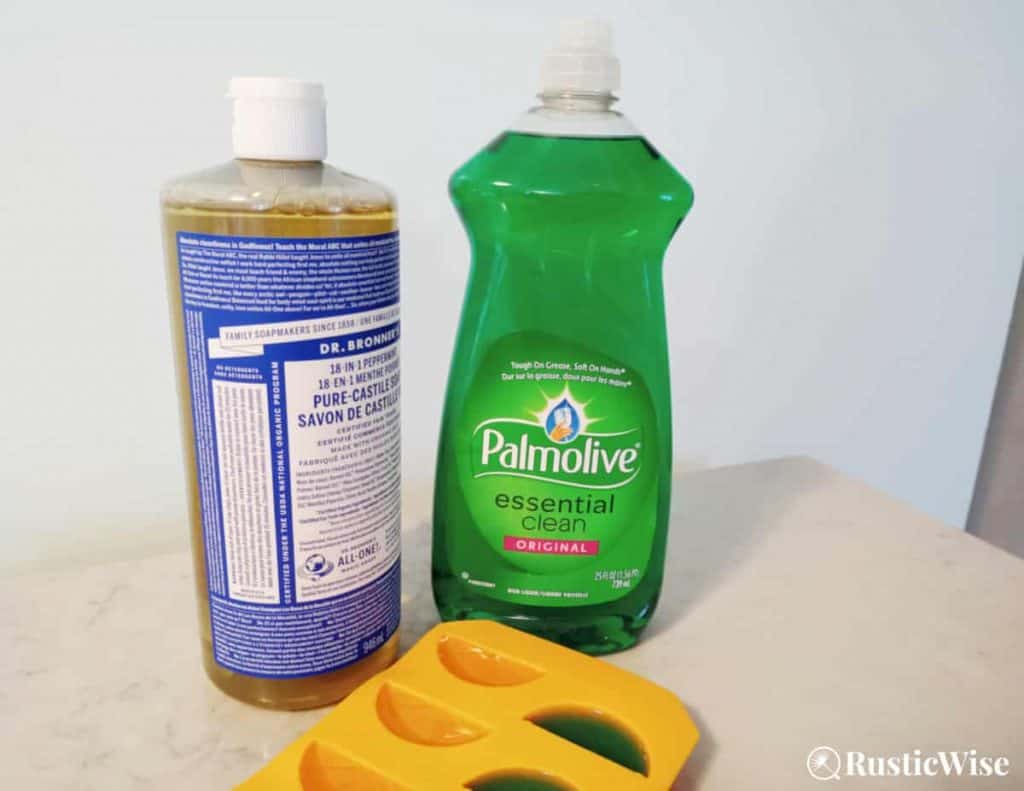
Credit: RusticWise
Does soap freeze? My experiment with dish soap and Castile soap
After hearing answers ranging from “dish soap doesn’t truly freeze” to “it turns slimy,” I decided to conduct my own little experiment using regular Palmolive liquid dish soap and Dr. Bronner’s Castile soap.
Method
Using a silicone ice cube tray, I filled three cavities with Palmolive dish soap, and three with Dr. Bronner’s.
I placed them in my freezer which is set to 0 degrees Fahrenheit (-18 degrees Celsius).
I checked the status of the soap at 1 hour, then again at 2 hours. After 2 hours, the frozen soap cubes were placed in bowls to defrost at room temperature.
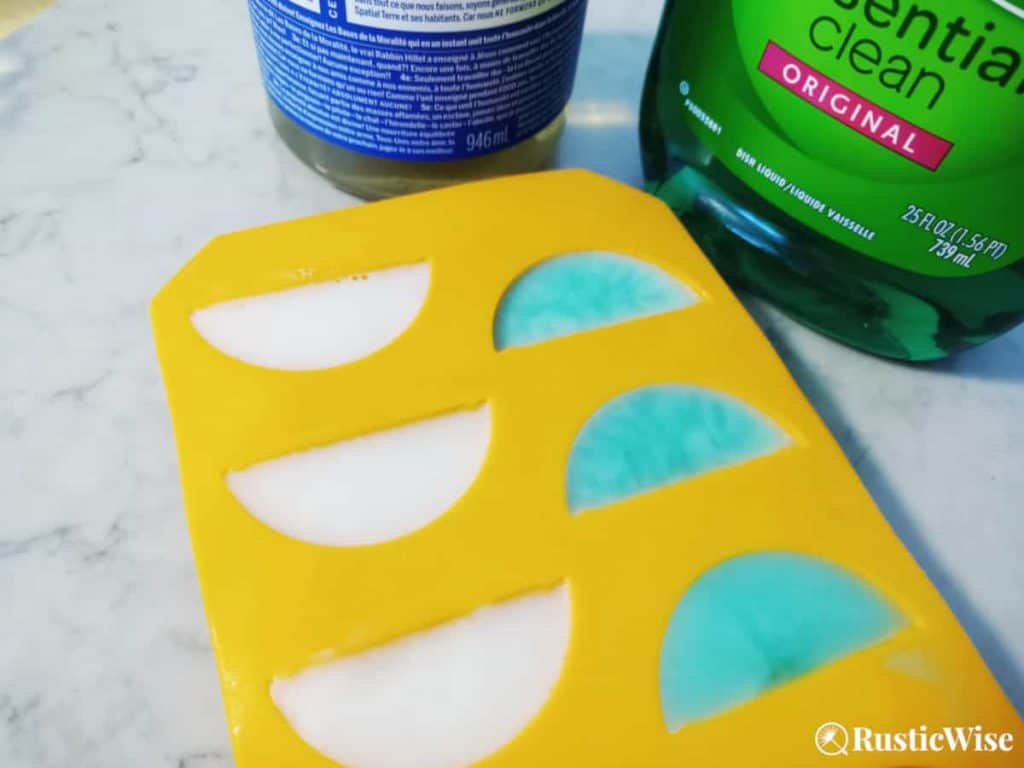
Credit: RusticWise
Limitations
Now, I know my experiment isn’t perfect and has limitations. For example, I didn’t freeze an entire bottle of dish soap, or Castile soap.
Freezing tiny ice cube portions is obviously not the same as freezing an entire bottle. I also only left the soap in the freezer for 2 hours.
The purpose of my experiment was to see if it is possible for liquid soaps to freeze (and not merely turn slushy). I also wanted to check the texture and condition of the soap after freezing and thawing.
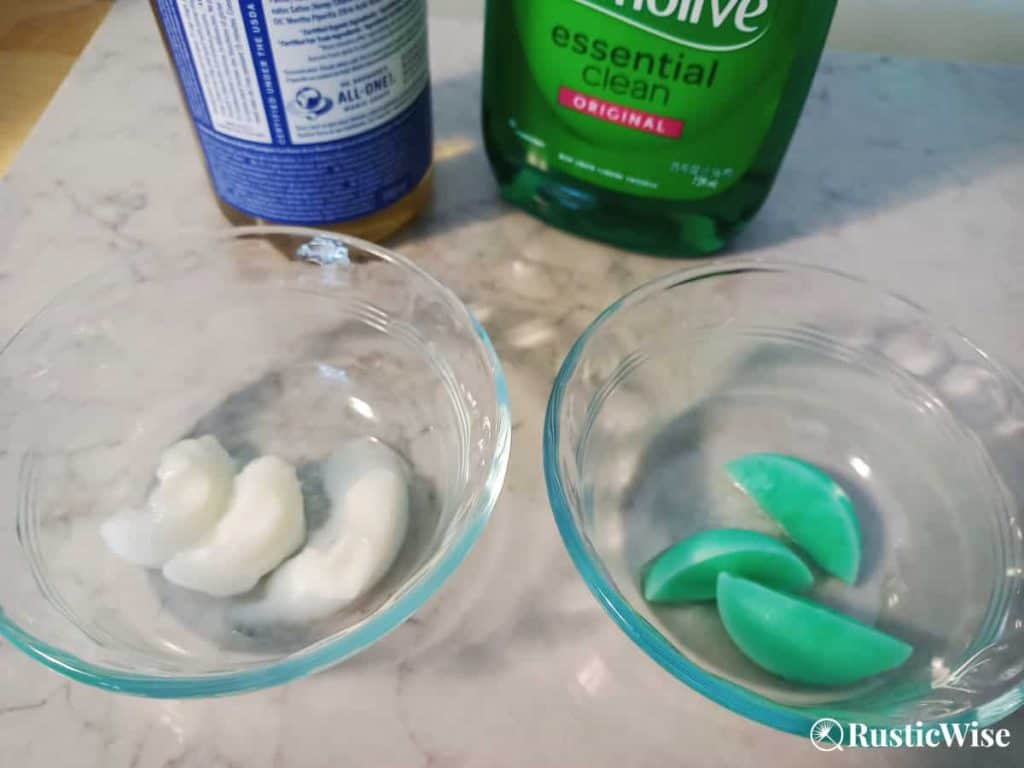
Credit: RusticWise
Results
At 1 hour in the freezer, both soaps were still “tacky” to the touch. They both felt like gel, but the Palmolive was noticeably firmer.
After 2 hours in the freezer, the Palmolive was frozen solid, like a regular ice cube. It popped out of the tray easily.
The Dr. Bronner’s didn’t freeze solid, instead it remained gooey. It was hard to remove cleanly from the tray, as you can see.
I then let the soap cubes sit in glass bowls to defrost at room temperature.
After fully thawed, both soaps returned to their regular viscosity, and both still worked as normal.
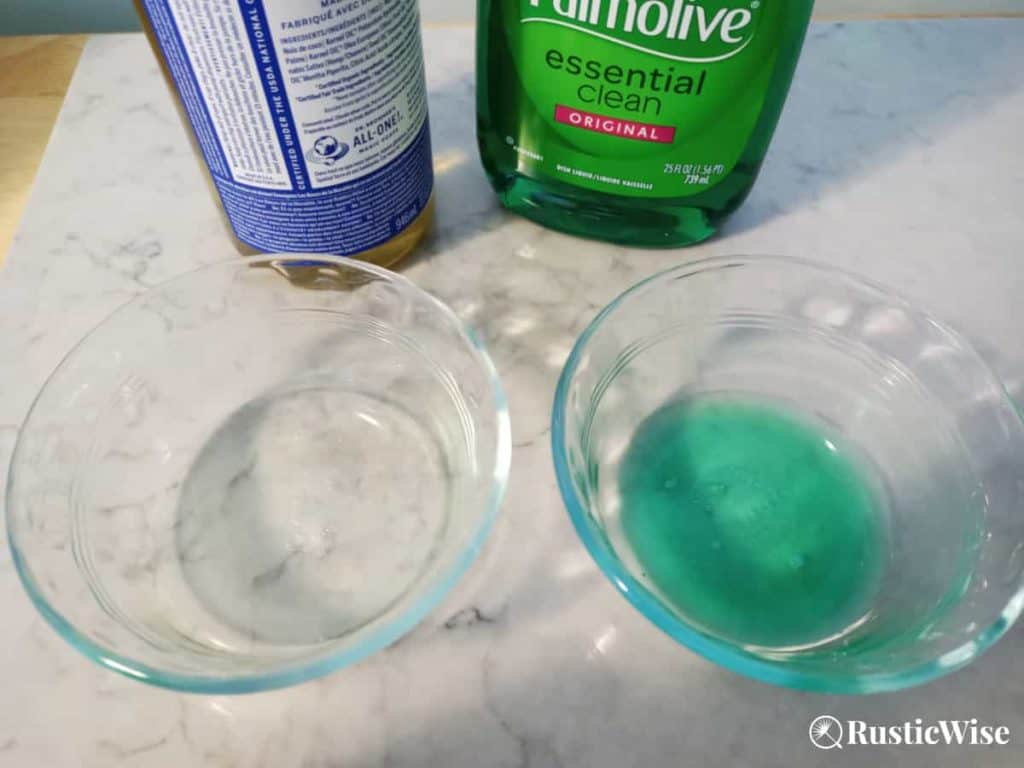
Credit: RusticWise
Can you still use soap after it has frozen?
This really depends on the type of soap, how long it has been frozen, and the condition it’s in. Yes, most liquid soaps can still be used after they have fully thawed at room temperature. Use your judgement and check to see how it works at removing grease, dirt, and grime from pots and pans.
Toss it if it’s unusable.
I’ve heard anecdotal stories of Castile soap bottles turning white and hardening when exposed to temperature drops. However, after warming at room temperature, the soap generally reverts to its normal state and is fine to use.
Here’s how to store your liquid soaps
The best way to store liquid soaps is in a room free from temperature fluctuations, or exposure to extreme temperatures.
Palmolive recommends you store their dishwashing soap at room temperatures between 68 to 77 degrees Fahrenheit (20 to 25 degrees Celsius).
Keep dish soap stored away from direct sunlight. The chemicals in dish soap may degrade quicker when exposed to heat and light. This can cause the soap to lose its cleaning power making it less effective at removing grease, dirt, and grime from pots and pans.
Keep dish soap out of reach of children as it’s poisonous if ingested.
Related questions
Can you freeze homemade soap bars?
If you’re making cold process, hot process, or melt and pour soap, some people stick their soap after it has been poured into molds to harden up in the freezer for a couple of hours. This can make it easier to remove from the molds and provide a more “opaque” look.
Or sometimes if soap is too hot, sticking soap batter in the freezer can prevent it from overheating. Avoid leaving in the freezer for too long as soap may turn brittle!
The drawback to doing this is the condensation that can form on the bars once out of the freezer.
In terms of long-term storage, I haven’t heard of anyone storing their bars of soap in the ice box. Cold process soap does best with plenty of air circulation, while melt and pour does best when tightly sealed.
Does Dawn dish soap freeze?
Yes, all solutions containing water will eventually freeze, and dish soap is no exception. Most liquid soaps will freeze around 12 to 14 degrees Fahrenheit (-10 to -11 degrees Celsius).
Do soap bubbles freeze?
Yes, if you live in a cold climate, you can turn blowing bubbles into a fun pastime in the winter. You just need a bubble wand, dish soap, and water. If you have subzero temperatures, you can make an easy soapy water solution using 1 part water to 4 parts dish soap. Each bubble contains a thin layer of water which freezes more readily than dish soap. Frozen bubbles are short-lived, however, so enjoy them while they last!
👉 If you like this post, see other Timeless Cleaning Tips You Need To Know. 🌟
Would you like more timeless tips via email?
Fun tips to help you live an independent, self-sustaining lifestyle. Opt-out at any time.


References
- American Cleaning Institute (ACI), Glossary of Cleaning Product Terminology, https://www.cleaninginstitute.org/understanding-products/how-read-labels/glossary-cleaning-product-terminology. Accessed October 2022.
- Helmenstine, Anne Marie (2019 October 3). “Freezing Temperature of Alcohol,” ThoughtCo. Accessed October 2022.

Author: Theresa Tesolin
Theresa is co-founder of RusticWise. She helps people unleash their inner DIY spirit by encouraging them to get dirty and make or grow something from scratch.

